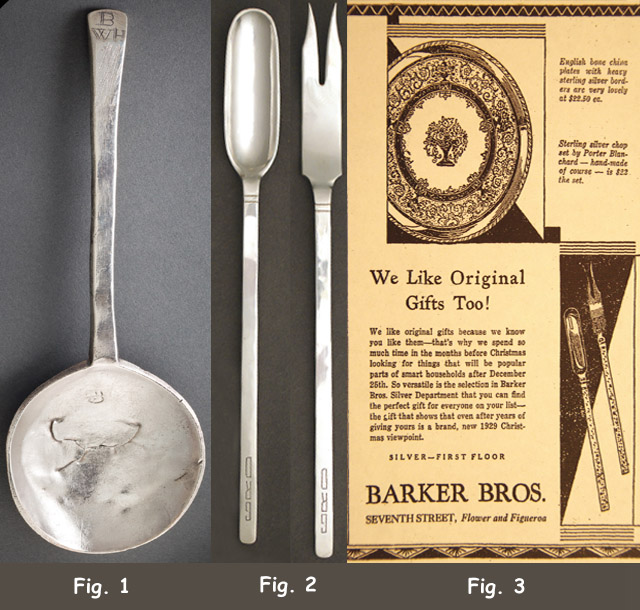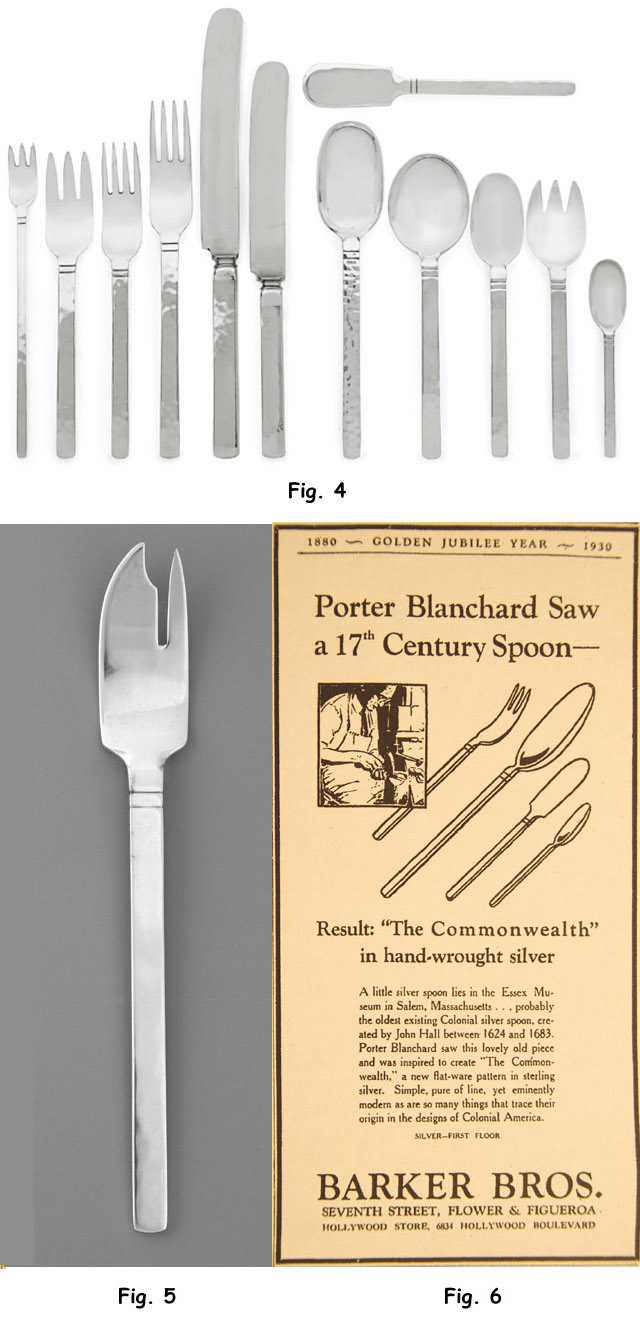allisonm
Posts: 4
Registered: Aug 2012
|
 posted 08-09-2012 09:56 PM
posted 08-09-2012 09:56 PM
  
[26-2315]Hi, I'm new here. I have inherited some pieces that I know little about. I'd like some input on what some of these pieces are, their intended use and care. I have some Porter Blanchard pieces that I inherited a few years ago and haven't yet used. Please help me understand what I have. In the article here, the fork is shown with a spoon that has a long narrow bowl. I have one like that, but the spoon that looks more like it's supposed to go with the the fork is wider and has a more pyramidal bowl. What do you think? And then what's the remaining spoon? Is the set for salad? (Please forgive my limited imagination.) Wouldn't the silver react with the vinegar or lemon in most salad dressings?
The pieces are very long, 12.25" - 12.75".
Looking forward to your input and opinions. [<gone from the internet> - 239d1d62.jpg] [<gone from the internet> - efa9c9bd.jpg] A post about the following article brought me to the forum, though I don't seem to be able to reply to it directly. Allison quote:
[<gone from the internet> .themagazineantiques.com/articles/southern-california-modernism-engages-colonial-new-england/]
Southern California modernism engages colonial New England
By W. Scott Braznell | An advertisement placed by the Los Angeles department store Barker Brothers in the Los Angeles Times on November 13, 1929, records the earliest appearance of Porter Blanchard's Commonwealth pattern, the first American flatware pattern to embrace modernism in both form and ornament (Fig. 3). Nine months later Barker Brothers featured Commonwealth again, in an advertisement illustrating a fork, spoons in two sizes, and a butter spreader, accompanied by the announcement, "Porter Blanchard Saw a 17th Century Spoon-Result: ‘The Commonwealth' in hand-wrought silver" (Fig. 6). The ad went on to identify a spoon in the Essex Institute by the early Boston silversmith John Hull (misspelled as John Hall) as Blanchard's inspiration (Fig. 1). The advertisement closed with the declaration that the pattern- its name derived from Massachusetts' official designation as the Commonwealth of Massachusetts- was "Simple, pure of line, yet eminently modern as are so many things that trace their origin in the designs of Colonial America."
 Fig. 1. Spoon made by John Hull (1624-1683) and Robert Sanderson (1608 -1693), Boston, c. 1664. Marked "IH" inside bowl and "RS" on back of handle; engraved "B/WH" on handle end for William Browne (1639-1715 or 1716) of Salem, who married Hannah Corwin in 1664. Silver, length 6 ⅛ inches. Peabody Essex Museum, Salem, Massachusetts.Fig. 2. Chop set in the Commonwealth pattern made by Porter Blanchard (1886-1973), probably Pacoima, California, c. 1936. Each marked "STERLING PORTER BLANCHARD" and "HANDMADE" on the back; and engraved "GRD" on handles for Gladys Rose Dimond, who married in 1936. Silver, length of spoon, 10 ½ inches. Private collection; photograph by the author. Fig. 3. Barker Brothers advertisement in the Los Angeles Times, November 13, 1929, p. 13.
In devising his pattern, Blanchard modified the early spoon by extending the length of the bowl to harmonize with his forks, whose short tines departed from the functionally superfluous longer length of traditional fork tines. He also employed a slightly wider handle than the early spoon to provide a surer grip. He boldly reconfigured the traditional butter knife form with a wider blade, and he refined the ice cream fork form by omitting unessential tines (see Figs. 4, 5). While many Blanchard flatware patterns have a plain surface, Commonwealth had a subtle hammered finish, a texture that became more pronounced after World War II when Blanchard's flatware production was taken over by his son-in-law Lewis Wise.Blanchard was born on February 28, 1886, in Littleton, Massachusetts. He acquired his silversmithing skills from his father, George Porter Blanchard, and about 1914 became the proprietor of the family shop in Gardner, Massachusetts, which specialized in flatware based on early American models.1 In 1923 he sold the shop and set out for southern California, where the emerging movie industry was creating wealth that fostered a demand for luxuries like handmade silverware. Shortly after arriving in Burbank, Blanchard began making his presence known in the local arts community. In a talk at the Los Angeles-based Ruskin Art Club in February 1924, he said he had come west to form an arts and crafts society in Los Angeles like those in Boston, Detroit, Philadelphia, and Portland, Oregon.2 Three months later, the Arts and Crafts Society of Southern California was founded with Blanchard as its president and Douglas Donaldson, one of California's foremost arts and crafts educators and a notable maker of metalwork and jewelry, as vice president.3  Fig. 4. Commonwealth flatware by Blanchard, probably Burbank, c. 1930. Photograph courtesy of Sotheby's. BraznellFig. 5. Commonwealth ice cream fork by Blanchard, Burbank or Pacoima, c. 1935. Marked "STERLING PORTER BLANCHARD" and "HANDMADE" on the back. Silver, length 6 ½ inches. Yale University Art Gallery, gift of Mr. and Mrs. Joe Kindig III. Fig. 6. Barker Brothers advertisement in the Los Angeles Times, August 3, 1930, p. 3.
As president of the new society, Blanchard engaged with local designers, some of whom were America's leading proponents of European modernism. When the society staged an exhibition of modernist furniture by the German émigré Kem Weber in 1927 Blanchard furthered his connection with prominent practitioners of Austro-German modernism, including émigré architects Richard J. Neutra, Rudolph M. Schindler, and Jock D. Peters.4 Blanchard's silver and pewter began to be sold by Barker Brothers, where Weber was the design director, and later design consultant.5 In 1928 Blanchard began producing pewter from Weber's designs.6An important exhibition of the "Decorative Arts of Today," which included the work of Weber, Neutra, Schindler, and Peters, was staged at the end of the year by Bullock's department store in Los Angeles. Blanchard was not listed among the participants, but Donaldson's designs were included, most likely ones he had developed through an association he had recently formed with Blanchard.7 The modernist designs of Blanchard's colleagues undoubtedly influenced him to produce Commonwealth, which has often been erroneously attributed to Weber.8 He designed the pattern for the movie actress Ann Harding, who had a taste for modern design, judging by the seating furniture in her home screening room.9 By drawing on early American silver and infusing his design with a modern sensibility, Blanchard bridged the arts and crafts and modern movements. Blanchard's exploration into progressive design began with the silver he exhibited at the 1928 Exhibition of the Decorative Arts at the National Arts Club in New York, where his "Dinner knife - solid handle" represents the earliest known departure from the traditional hollow knife handle constructed in two parts.10 It made possible the sleek solid handle of the Commonwealth knife of the following year.
Several American flatware designs of 1928 and 1929 were considered novel, modern, or innovative, but only Commonwealth embraced modernism in both form and ornament. While Erik Magnussen's Modern American pattern of 1928, for example, is modern in decoration, with its spare incised lines, it was fabricated with dies adapted from Gorham's earlier Covington pattern (1914).11 Eliel Saarinen's 1929 modern ergonomic knife design, with its shortened blade and longer handle, made its initial appearance in models by four manufacturers displayed at The Architect and the Industrial Arts exhibition held at the Met¬ropolitan Museum of Art that year.12 The knife design was first put into production by the International Silver Company in its Charm and Silhouette patterns of 1929; but while both the knives and the forks in those patterns are "modern" in their proportions, their reliance on ornament remained traditional.13 Blanchard exhibited Commonwealth throughout the 1930s and it was produced by his shop with subtle variations into the 1980s.14 In the boom economy of the late 1920s, when retailers across the nation were promoting modern styles, unique factors in southern California fostered the introduction of modernism in American silver. In 1930 Dorothy Oyer observed, "There is a steady contri¬bution coming from the ability of men like Porter Blanchard to the artistic growth of the West. It should be recognized."15 And so it has been, with Commonwealth in the vanguard. 1 Leslie Greene Bowman, "Arts and Crafts Silversmiths: Friedell and Blanchard in Southern California," in Silver in the Golden State: Images and Essays Celebrating the History and Art of Silver in California, ed. Edgar W. Morse (Oakland Museum History Department, Oakland, Calif., 1986), p. 48. 2 "Arts and Crafts Society Planned for Los Angeles," Los Angeles Times, February 10, 1924, p. 6. 3 "The Arts and Crafts Society of Southern California," California South¬land, vol. 6 (August 1924), p. 24; Marion Hugus Clark, "The Arts and Crafts Society," ibid., vol. 7 (January 1925), p. 11. 4 "Notes and Briefs," Los Angeles Times, November 13, 1927, p. C21. 5 "Silversmith's Craft Finds Place Today," ibid., December 4, 1927, p. C20; David Gebhard and Harriette Von Breton, Kem Weber: The Mod¬erne in Southern California, 1920 through 1941 (University of California, Santa Barbara Art Galleries, Santa Barbara, Calif., 1969), pp. 39-40. 6 Gebhard and Von Breton, Kem Weber, pp. 40, 64. 7 An Exposition of the Decorative Arts of Today Presented by Bullock's, December 1928 (Biographical files, Jock D. Peters Collection, Architecture and Design Collection, University Art Museum, University of California, Santa Barbara). "Art," California Southland, vol. 9 (May 1927), p. 5; "News and Notes," Bulletin of the Society of Arts and Crafts (Boston), vol. 11 (May 1927), p. 4. 8 Bowman, "Arts and Crafts Silversmiths," p. 49. 9 Ibid., p. 55. For a photo¬graph of Harding's screening room, see hometheaterblog.com/hometheater/2006/05/ celebrity-home-theaters-past-and-present/; accessed May 22, 2012. 10 "Articles sent to Arts Club," Records of the National Arts Club, New York, 1898-1960, Archives of American Art, Smithsonian Institution, mi¬crofilm roll number 4245, frames 130, 191. "Handwrought Silver Produced at Pacoima," news clipping, San Fernando Valley Times, c. 1946, Porter Blanchard Papers, Archives of American Art, Smithsonian Institution. 11 For Modern American flatware see "American Decorative Arts at the Art Center," Good Furniture, vol. 32 (January 1929), p. 48, no. 5; for Covington flatware see Philip Johnson, Machine Art (Museum of Modern Art, New York, 1934; reprint 1969), nos. 160-162. 12 Jewel Stern, Modernism in American Silver: 20th Century Design (Yale University Press, New Haven, with the Dallas Museum of Art, 2005), p. 106. 13 "Table Knives Depart from Tradition," National Jeweler, vol. 26 (September 1929), p. 127. 14 Illustrated Catalogue of the Official Art Exhibition of the California Pacific International Exposition (San Diego, 1935), p. 24. "Exhibition Silver at the Metropolitan Museum," House and Garden, vol. 72 (July 1937), p. 58, no. 4. For the Golden Gate International Exposition, San Francisco, see Frank Rogers, "Trends," Gift and Art Buyer, vol. 35 (February 1939), pp. 36-37 and "The Calendar: Silver by Porter Blanchard," California Arts and Architecture, vol. 57 (April 1940), p. 2. For later production see "200th Anniversary for Porter Blanchard," Silver, vol. 21 (November-December 1988), p. 31. 15 Dorothy Oyer, "A Master Crafts¬man," California Arts and Architecture, vol. 38 (October 1930), p. 7.
--------------------------------- IP: Logged |


 SMP Silver Salon Forums
SMP Silver Salon Forums

 New members post here
New members post here

 Porter Blanchard pieces
Porter Blanchard pieces
















